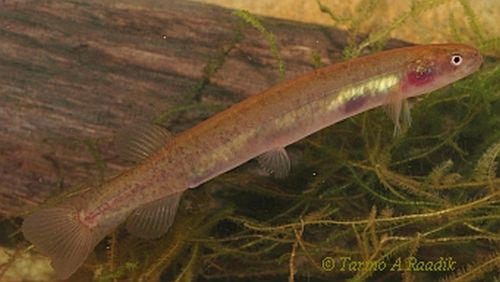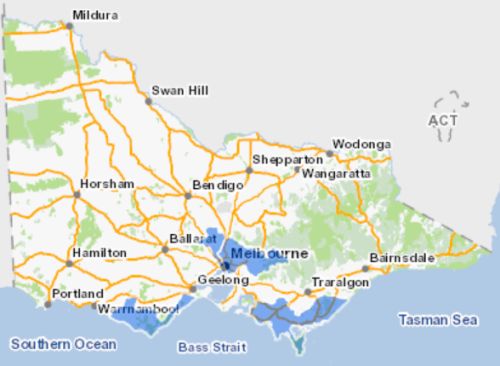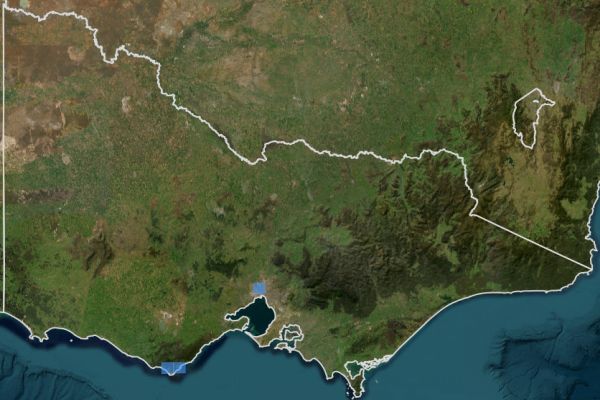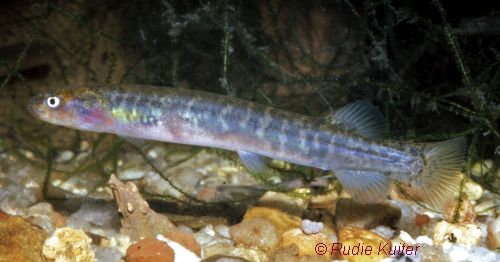Australian Mudfish
Australian MudfishNeochanna cleaveri | |
|---|---|
| Kingdom: | Animalia |
| Phylum: | Chordata |
| Class: | Actinopterygii |
| Order: | Osmeriformes |
| Family: | Galaxiidae |
| Status | |
| World: | Endangered (IUCN 2025) |
| Australia: | Not listed (EPBC Act) |
| Victoria: | Endangered (FFG threatened list - March 2025) |
| South Australia: | Critically endangered (DEH 2009) |
| Tasmania: | Not listed |
| Victorian FFG: | Listed Action Statemenmt No. 115 |

The Australian Mudfish (Neochanna cleaveri) is endemic to south-eastern Australia, being only found in Victoria, Tasmania and South Australia.
This species was first recorded in Tasmania and was previously referred to as the Tasmanian Mudfish Galaxias cleaveri (Scott, 1934). It was only discovered on mainland Australia at Wilson's Promontory in 1980 (Jackson & Davies 1982) and is currently recorded from a small area in south-esatern South Australa and 13 locations in southern Victoria.
In common with other members of the Galaxiid family, the Australian Mudfish is a small tubular, elongate scaleless fish having a distinct lateral line and single dorsal fin situated towards the rear of its body. The Australian Mudfish grows to 80-140mm, is generally greenish brown, brown or blackish above, it is most similar to the Broad-finned Galaxias Glaxias brevipinnis and the Mountain Galaxias Galaxias olidus. Some of its more obvious distinguishing features are: dorsal fin situated above the anal fin, small eyes, rounded caudal fin and pronounced tubular nostrils (Cadwallader & Backhouse 1983, Koehan & Raadik 1991). It differs from other members of the Galaxiid family in its capacity to aestivate (survive out of water) and has been placed in the genus Neochanna, which has six recognised species (one endemic to Australia and five endemic to the New Zealand region). Waters & McDowall (2004) determined that the Australian Mudfish is sister to a clade of five non-diadromous New Zealand mudfishes.
Distribution
The Victorian mainland populations of Australian Mudfish were once concentrated in the Aire River valley, Calder River and Wye River and the Barham River valley in the Otway Ranges bioregion as well as Wilsons Promontory National Park. Adult fish have were last recorded from the Yarra River at Dights Falls in 199 and the Maribynong River in 2008.

Potential distribution of Australian Mudfish based on Species Habitat Distribution Models developed for Australian Mudfish which provide detailed spatial mapping describing important suitable habitat within the current extent of the species. (VBA 2025).

Known records of adult Australian Mudfish between 2000 to 2025.
Tribuary drain of Barham River (near Apollo Bay) 2011, 2012 & 2022.
Aire River drain 2011 and Maribynong River upstream in Niddrie area 2008. Source: VVB 2025.
Extensive surveys have been carried out between the main stronghold areas (Otway Ranges & Wilsons Promontory) to determine the full extent of distribution but only a small number of sites have been found with adult fish. In addition, most sites discovered to-date have only revealed low numbers of adult fish in surveys.
New sampling techniques developed in recent years has focused on the collection of migrating larvae rather than trying to locate individual adult fish which is difficult for this species. Refinement of larvae collection and analysis has enabled a greater understanding of the species distribution with several new populations discovered in recent years, e.g. Cardinia Creek, Maribyrnong River, Bunyip Creek, Lang Lang Creek and west side Wilsons Promontory (Raadik 2017).
Ecology & Habitat
The Australian Mudfish is diadromous (has a marine phase in its life cycle). Spawning is thought to occur during mid-winter in freshwater areas; it is thought that either eggs or lavae are washed down to the sea and by spring a juvenile "white bait" phase begins migrating from the sea into freshwater habitats which comprise swampy sites, drains and semi permanent waters with abundant aquatic vegetation. The Australian Mudfish is known to tolerate short periods without water (aestivate) by burrowing itself into mud substrate or sheltering under rocks and logs (Cadwallader & Backhouse 1983, Koehan & Raadik 1991).
Australian Mudfish tend to inhabit low lying areas and have not been recorded above 25 m elevation (Raadik 2017).
Threats
- Loss of shallow freshwater wetlands that are contiguous with coastal streams is considered to be a major threat to this species.
- Habitat degradation caused by stock pugging up waterway margins and reduced aquatic vegetation.
- Predation and competition from introduced fish such as Brown Trout, Redfin and Mosquitofish may reduce population viability though impacting on the juvenile "white bait" stage as young fish migrate into freshwater areas, or on adult fish where introduced species are abundant.
- Climate change and reduced rainfall may affect the presence and quality of freshwater wetlands which may also impact on spawning and access to and from the sea; Koehn & Raadik (1991) also consider that potential increases to tidal limit may alter wetland habitat for mature Australian Mudfish.

Conservation & Management
The conservation status of Australian Mudfish was re-assessed from Critically Endangered in 2013 to Endangered in 2020 as part of the Conservation Status Assessment Project – Victoria (DELWP 2020). This species is now listed as Endangered in Victoria and under the Flora and Fauna Guarantee Act 1988 - Threatened List - June 2021 (DELWP 2021).
Research has been focused on identifing appropriate habitat in data gap areas and conduct targeted surveys for Australian Mudfish, for example, between Geelong and Melbourne, Melbourne and Wilsons Promontory.
Further research into the movement of larvae is required to determine if they have a marine phase, mixing in the waters of Bass Strait or if they remain in the estuary environment of the source river system. This information combined with further genetic studies could determine if mainland populations are discrete from Tasmanian populations and the level of genetic isolation in Victorian sterams.
Aire River & Calder River Wetlands
This area is considered one of the stronghold areas on mainland Australia
Liaise with Corangamite Catchment Management Authority (CCMA) to ensure protection of habitat.
Undertake intensive population monitoring.
Protect Australian Mudfish habitat with co-operation of landholders by erecting and maintaining fencing on Crown Land river frontages and selected areas on private land to exclude domestic stock.
Belmont Common
Undertake intensive population monitoring.
Include in planning scheme overlay – completed.
Wye River
Monitor populations of Australian mudfish at this location to determine population status, habitat preference, biological requirements and also to further clarify potential threats to this population.
Fence both sides of the river above caravan park to protect riparian zone - completed.
Barham River
In May 2011 a team of researchers from the Arthur Rylah Institute were conducting fish surveys on the Barham River at Apollo Bay and discovered an Australian Mudfish in a drain connected to the river. This is a significant finding as it is highly likely a population exists in the low lying drains. It also fills a gap in the populations between the Air River and Wye River. This occurrence will also prompt the need for DELWP, CCMA and Colac Otway Shire to look at management measures which will ensure the population continues to survive in an area that is subject to increasing human influences of development and ecological change.
Dights Falls
- Only one individual fish has been recorded at this site but further surveys required to determine the status of the population.
- Undertake intensive population monitoring
Freshwater creek - Wilsons Promontory National Park
- Undertake targeted surveys for Australian Mudfish to determine the abundance ans extent of the population.
- It is necessary for Parks Victoria to protect site from all forms of heavy machinery used for the purpose of fire protection works.
Miranda Creek, Wilsons Promontory National Park
A new record was discovered in 2002. Further surveys required to determine the abundance and extent of the population.
New sites from larvae collection method
(Raadik 2017)
Each of these new sites will require follow up surveys & monitoring.
- Cardinia Creek
- Maribyrnong River
- Bunyip Creek
- Lang Lang Creek
- Creek on western side of Wilsons Promontory National Park
References & Links
Cadwallader, P.L., Backhouse, G.N. (1983) A Guide to the Freshwater Fish of Victoria, Victorian Government Printing Office, Melbourne.
DEH (2009) Action Plan for South Australian Freshwater Fishes, Department of Environment & Heritage, South Australia.
DELWP (2020) Provisional re-assessments of taxa as part of the Conservation Status Assessment Project – Victoria 2020, Department of Environment Land Water and Planning, Victoria.
DSE (2013) Advisory List of Threatened Vertebrate Fauna in Victoria. Department of Sustainability & Environment (now Department of Environment, Land, Water & Planning, Victoria).
FFG Threatened List - March 2025
IUCN (2025) Whiterod, N., Hammer, M., Freeman, R., Raadik, T. & Coleman, R. 2019. Neochanna cleaveri. The IUCN Red List of Threatened Species 2019: e.T122904064A123382186. https://dx.doi.org/10.2305/IUCN.UK.2019-3.RLTS.T122904064A123382186.en. Accessed on 15 April 2025.
Jackson, P.D., Davies, J.N. (1982) Occurrence of the Tasmanian mudfish, Galaxias cleaveri Scott, on Wilsons Promontory: first record from mainland Australia. Proceedings of the Royal Society of Victoria 94: 49-52.
Koehn, J.D., O’Connor, W.G. (1990) Distribution of freswater fish in the Otway Region, South-Western Victoria, Proceedings of the Royal Society of Victoria 102 (1): 29-39.
Koehan, J.D., Raadik, T.A. (1991) The Tasmanian Mudfish, Galaxias cleaveri Scott, 1934, In Victoria, Proceedings of the Royal Society of Victoria, 103 (2): 77-86.
Macmillan, L., Kunert, C., Blakers, M. (1987) Nature conservation value and status of rivers in the south western region, Victoria. Report to the Victorian Department of Water Resources, Department of Planning Policy and Landscape, Royal Melbourne Institute of Technology.
Raadik (2017) pers. coms. T.A. Raadiik, Arthur Rylah Institute, Heidelberg. Department of Environment, Land, Water & Planning, Victoria.
Tunbridge, B.R., Glenane, T.G. (1983) Fisheries Value and Classification of Fresh and Estuarine Waters in Victoria. Victorian Government Printing Office, Melbourne.
VBA (2025) Victorian Biodiversity Atlas, Department of Energy, Environment and Climate Action (DEECA).
Waters, J.M., McDowall, R.M. (2004) Phylogenetics of the australasian mudfishes: Evolution of an eel-like body plan, Molecular Phylogenetics and Evolution, Vol 37 (2) November 2005, pp 417-425.
VVB (2025) Visualising Victoria's Biodiversity map portal.
More Information
Flora & Fauna Gaurantee Act 1988, Victoria. Australian Mudfish Action Statement No.115 pdf

